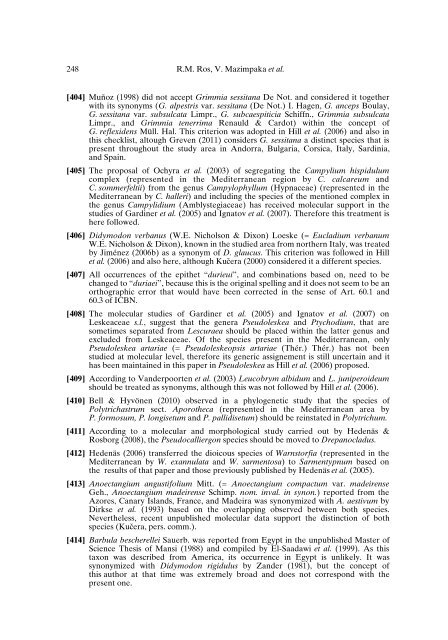Mosses of the Mediterranean, an annotated checklist - Optima-bot.org
Mosses of the Mediterranean, an annotated checklist - Optima-bot.org
Mosses of the Mediterranean, an annotated checklist - Optima-bot.org
You also want an ePaper? Increase the reach of your titles
YUMPU automatically turns print PDFs into web optimized ePapers that Google loves.
248 R.M. Ros, V. Mazimpaka et al.[404] Muñoz (1998) did not accept Grimmia sessit<strong>an</strong>a De Not. <strong>an</strong>d considered it toge<strong>the</strong>rwith its synonyms (G. alpestris var. sessit<strong>an</strong>a (De Not.) I. Hagen, G. <strong>an</strong>ceps Boulay,G. sessit<strong>an</strong>a var. subsulcata Limpr., G. subcaespiticia Schiffn., Grimmia subsulcataLimpr., <strong>an</strong>d Grimmia tenerrima Renauld & Cardot) within <strong>the</strong> concept <strong>of</strong>G. reflexidens Müll. Hal. This criterion was adopted in Hill et al. (2006) <strong>an</strong>d also inthis <strong>checklist</strong>, altough Greven (2011) considers G. sessit<strong>an</strong>a a distinct species that ispresent throughout <strong>the</strong> study area in Andorra, Bulgaria, Corsica, Italy, Sardinia,<strong>an</strong>d Spain.[405] The proposal <strong>of</strong> Ochyra et al. (2003) <strong>of</strong> segregating <strong>the</strong> Campylium hispidulumcomplex (represented in <strong>the</strong> <strong>Mediterr<strong>an</strong>e<strong>an</strong></strong> region by C. calcareum <strong>an</strong>dC. sommerfeltii) from <strong>the</strong> genus Campylophyllum (Hypnaceae) (represented in <strong>the</strong><strong>Mediterr<strong>an</strong>e<strong>an</strong></strong> by C. halleri) <strong>an</strong>d including <strong>the</strong> species <strong>of</strong> <strong>the</strong> mentioned complex in<strong>the</strong> genus Campylidium (Amblystegiaceae) has received molecular support in <strong>the</strong>studies <strong>of</strong> Gardiner et al. (2005) <strong>an</strong>d Ignatov et al. (2007). Therefore this treatment ishere followed.[406] Didymodon verb<strong>an</strong>us (W.E. Nicholson & Dixon) Loeske (= Eucladium verb<strong>an</strong>umW.E. Nicholson & Dixon), known in <strong>the</strong> studied area from nor<strong>the</strong>rn Italy, was treatedby Jiménez (2006b) as a synonym <strong>of</strong> D. glaucus. This criterion was followed in Hillet al. (2006) <strong>an</strong>d also here, although Kuªera (2000) considered it a different species.[407] All occurrences <strong>of</strong> <strong>the</strong> epi<strong>the</strong>t “durieui”, <strong>an</strong>d combinations based on, need to bech<strong>an</strong>ged to “duriaei”, because this is <strong>the</strong> original spelling <strong>an</strong>d it does not seem to be <strong>an</strong>orthographic error that would have been corrected in <strong>the</strong> sense <strong>of</strong> Art. 60.1 <strong>an</strong>d60.3 <strong>of</strong> ICBN.[408] The molecular studies <strong>of</strong> Gardiner et al. (2005) <strong>an</strong>d Ignatov et al. (2007) onLeskeaceae s.l., suggest that <strong>the</strong> genera Pseudoleskea <strong>an</strong>d Ptychodium, that aresometimes separated from Lescuraea should be placed within <strong>the</strong> latter genus <strong>an</strong>dexcluded from Leskeaceae. Of <strong>the</strong> species present in <strong>the</strong> <strong>Mediterr<strong>an</strong>e<strong>an</strong></strong>, onlyPseudoleskea artariae (= Pseudoleskeopsis artariae (Thér.) Thér.) has not beenstudied at molecular level, <strong>the</strong>refore its generic assignement is still uncertain <strong>an</strong>d ithas been maintained in this paper in Pseudoleskea as Hill et al. (2006) proposed.[409] According to V<strong>an</strong>derpoorten et al. (2003) Leucobrym albidum <strong>an</strong>d L. juniperoideumshould be treated as synonyms, although this was not followed by Hill et al. (2006).[410] Bell & Hyvönen (2010) observed in a phylogenetic study that <strong>the</strong> species <strong>of</strong>Polytrichastrum sect. Aporo<strong>the</strong>ca (represented in <strong>the</strong> <strong>Mediterr<strong>an</strong>e<strong>an</strong></strong> area byP. formosum, P. longisetum <strong>an</strong>d P. pallidisetum) should be reinstated in Polytrichum.[411] According to a molecular <strong>an</strong>d morphological study carried out by Hedenäs &Rosb<strong>org</strong> (2008), <strong>the</strong> Pseudocalliergon species should be moved to Drep<strong>an</strong>ocladus.[412] Hedenäs (2006) tr<strong>an</strong>sferred <strong>the</strong> dioicous species <strong>of</strong> Warnstorfia (represented in <strong>the</strong><strong>Mediterr<strong>an</strong>e<strong>an</strong></strong> by W. ex<strong>an</strong>nulata <strong>an</strong>d W. sarmentosa) to Sarmentypnum based on<strong>the</strong> results <strong>of</strong> that paper <strong>an</strong>d those previously published by Hedenäs et al. (2005).[413] Anoect<strong>an</strong>gium <strong>an</strong>gustifolium Mitt. (= Anoect<strong>an</strong>gium compactum var. madeirenseGeh., Anoect<strong>an</strong>gium madeirense Schimp. nom. inval. in synon.) reported from <strong>the</strong>Azores, C<strong>an</strong>ary Isl<strong>an</strong>ds, Fr<strong>an</strong>ce, <strong>an</strong>d Madeira was synonymized with A. aestivum byDirkse et al. (1993) based on <strong>the</strong> overlapping observed between <strong>bot</strong>h species.Never<strong>the</strong>less, recent unpublished molecular data support <strong>the</strong> distinction <strong>of</strong> <strong>bot</strong>hspecies (Kuªera, pers. comm.).[414] Barbula bescherellei Sauerb. was reported from Egypt in <strong>the</strong> unpublished Master <strong>of</strong>Science Thesis <strong>of</strong> M<strong>an</strong>si (1988) <strong>an</strong>d compiled by El-Saadawi et al. (1999). As thistaxon was described from America, its occurrence in Egypt is unlikely. It wassynonymized with Didymodon rigidulus by Z<strong>an</strong>der (1981), but <strong>the</strong> concept <strong>of</strong>this author at that time was extremely broad <strong>an</strong>d does not correspond with <strong>the</strong>present one.






